Tomato
Introduction
Commonly known as a tomato plant. Also known as Nyanya in Swahili
Tomato is one of the most produced and consumed vegetables in Kenya. It is an Important cash crop for smallholder farmers and mainly grown in open field and also in the green house. It is rich in Vitamin A, C and Lycopene. It’s either eaten fresh, added to salads, cooked as a vegetable or processed into tomato paste, jam, sauce, puree and juice.
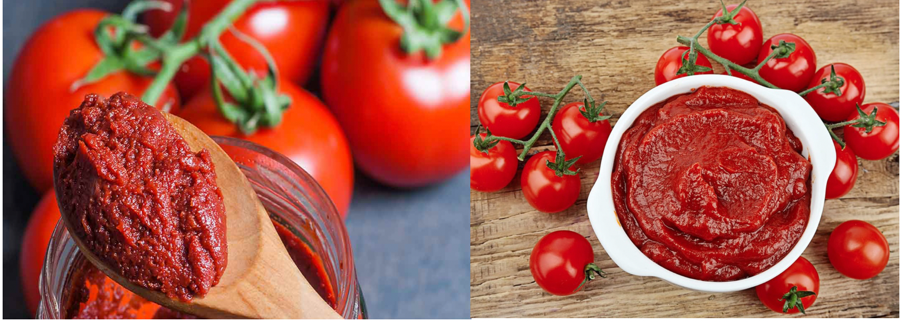
Variety selection
The choice of variety should be based on fruit quality, adaptability and resistance/tolerance to diseases and pests, quality (firmness), plant growth habit, availability and suitability to the growing conditions, the specific market (preference by customers), and the planting time.
Rio Grande

Description
- Grown for fresh market and processing.
- Suitable for irrigated open field.
- Matures in 75-80 days after transplanting.
- Produces elongated pear-shaped, bright red, pulpy fruit weighing 74gm on average.
- It is tolerant to verticillium and fusarium wilt.
- Performs best in medium to lower-medium zones with a potential yield of 84t/ha.
Cal j

Description
- It’s an open field variety.
- Tolerant to verticilium & fusarium wilts.
- Matures in 75 - 85 days after transplanting and Produces red blocky shaped fruits that store and transport well.
- Has a Yield potential of 11,000 – 13,000kg per acre.
Onyx F1
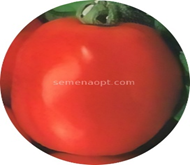
Description
- Suitable for open field cultivation in medium to lower medium zones.
- Matures in 70 days after transplanting with a yield potential of 45t/ha.
- Produces firm, oval-round fruits with deep red color that store and transport well.
Roma VF
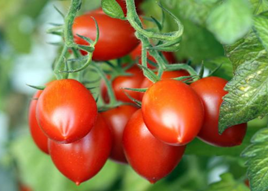 Photo Credit: Ben185/Getty
Photo Credit: Ben185/Getty
- It’s an open field variety and is very ideal for processing/canning.
- Plants do not require staking.
- Matures in 80-85 days after transplanting and has a yield potential of 83t/ha. with a yield potential of 45t/ha.
- Produces deep red coloured fruits that are pear-shaped and firm with few seeds. The fruits also have thick walls and dense flesh weighing 53gms on average.
Kilele F1

Description
- Tolerant to Tomato Yellow Leaf Curl Virus, Tomato Mosaic Virus, Verticillium, Fusarium Wilt & Nematodes
- Fruits are firm and elongated with a shelf life of 21 days
- Matures in 75 days after transplanting with a yield potential of 30,000 – 35,000kg per acre
Assila F1
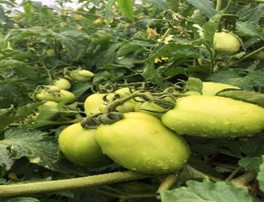
Description
- Early maturing, open field variety
- Tolerant to Tomato Yellow Leaf Curl Virus (TYLCV) & nematodes
- Fruits are sweet, red in colour, oval shaped and heavy with Good keeping quality & transportability
- Matures in 75 days after transplanting with a yield potential of 23,000kgs per acre
Rambo F1
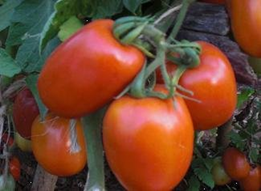
Description
- Vigorous growing open field variety with
- Tolerant to Bacterial wilt, Bacterial spot, Fusarium wilt, Verticilium wilt and Nematodes
- Fruits are uniformly set and firm with good shelf life & transport quality
- Matures in 75 days after transplanting with a yield potential of 30,000
Tylka F1
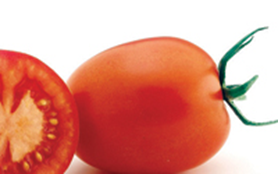
Description
- Both greenhouse and outdoor variety.
- Very vigorous plants with good cover
- Tolerant to Tomato Yellow Leaf Curl Virus Tomato Mosaic Virus, Verticillium & Fusarium Wilt.
- Fruits are firm, oval, elongated, non-green back, and smooth with an average frit weight of 120-130g.
- Matures in 75 days after transplanting with a yield potential of 70,000-78000 kgs per acre (… kgs/plant).
Other Tomato Varieties
Eden F1 - Description
- Vigorous growing open field variety
- Tolerant to Alternaria Canker, Verticillium Wilt, Fusarium Wilt, Nematodes and Bacterial Speck
- Fruits are Deep red and blocky with long shelf life
- Matures in 75 days after transplanting with a yield potential of 40,000 – 50,000kg per acre
Anna F1 - Description
- Hybrid greenhouse variety suitable for fresh market
- Tolerant to Fusarium, Verticillium Wilt, Alternaria Stem Canker and Nematodes
- Fruits are red and blocky oval
- Matures in 75 days after transplanting with a yield potential of 18kgs/plant (64,000 kgs per acre)
Chonto F1 - Description
- It is a hybrid premium tomato variety suited to greenhouse cultivation
- Good calyx retention
- Matures in 75 days
- Can harvest for up to 8 months
- Fruits weight 150-200g
- Yield potential of up to 28-36tonnes from 8x30m greenhouse
- Fruits have a long shelf life of up to 21 days
Bravo F1 - Description
- It is a hybrid greenhouse tomato growth
- Matures in 75 days from transplanting
- Fruits weight 120-150gms
- Has a yield potential of 24-31 tonnes from 8x30m greenhouse
- Fruits have a long shelf life of up to 21 days at room temperature
- Resistant to tomato Yellow Leaf Curl Virus, Fusarium Wilt, Verticillium Wilt, Grey Leaf Spot and Nematode
Mavuno F1 - Description
- It is a hybrid tomato variety that is ideal for greenhouse cultivation
- Matures in 70 days after transplanting
- Has continuous fruit set
- Long harvest duration of up to 12 months
- Fruits weight 100-130g
- Has a yield Potential of up to 24-26 tonnes from 8x30m greenhouse
- Long shelf life (up-to 21 days)
- Tolerant to bacterial and Fusarium wilt, Tomato Mosaic Virus, Blossom end rot and nematodes
Cherry tomato Koko - Description
- It is a high yielding and high quality tomato cultivar suitable for production under Kenyan conditions
- Was introduced from Japan and evaluated at JKUAT
- Matures in 75 days to maturity
- Long harvesting period of up to 3 years
- Round, red, sweet, flavored fruit
- Adapted to varying climates
- Disease resistant
- Has a Yield potential of 2.5kg of fruits/plant per year (1.15tonnes from 8x30m greenhouse)
- Can be harvested 3 days in a week
Cherry tomato (Chika) - Description
- This is a high yielding and high quality Cherry tomato cultivar suitable for production under Kenyan conditions
- The cultivar introduced from Japan has been evaluated at JKUAT and has the following features:
- 75 days to maturity (start of harvesting), · Indeterminate with long harvesting period up to 3 years possible
- Round, red, sweet, flavored fruit
- Adapted to varying climates. ·
- Disease resistant.
- Yield: 2.5 kg/ plant per year (1.15ton /240m2 greenhouse)
- Harvested 3 days per week
- Loosen Compacted soil should by deep ploughing. This enables the root system to spread deep (40 – 60cm).
- Level the field and install drainage tiles for sites with uneven topography, ditches and waterlogged sites.
- Ensure reliable water source as tomatoes require frequent watering.
- Low soil pH can be corrected by addition of Lime (CaCo3). High soil pH or Sodic soils remediation is done by application of Gypsum (CaS04).
- Soil borne Pathogens and Nematodes can be controlled by soil solarization after a deep plough.
- To manage weeds before planting, one can water the field after full preparation and the weeds that germinate are then eliminated by hoeing or by use of herbicides.
- Regular ridges should be done about 30 - 35 cm high and 25 – 30 cm wide.
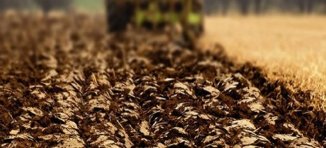
Nursery preparation (Pre planting)


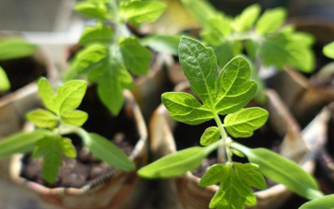
- Seeds are either sown on the ground in a nursery bed or planting pots/seed trays.
- Prepare Nursery in a well-drained field that had not been planted with same family plants before.
- Prepare soil to a fine tilth then make raised beds of 1m width.
- Seeds should be sown in rows 6-10 cm apart and 2-3cm deep.
- Cover the seedbed surface with a thin layer of dry grass or straw mulch and water the seedlings regularly so that the soil is moist.
- Upon germination, the seedbed cover should be removed to prevent chocking the young seedlings.
- Protect the nursery seedbed from direct sunlight by covering with grass mulch or shade net at a height of about 1metre from the ground.
- For 1 acre, use 60-100gms of seed for outdoor farming and 30-50gms to raise greenhouse seedlings.
- Treated, Good Quality seed variety should be used and planted at 0.5cm deep.
- Transplanting should take place one month after sowing (4-6 leaves stage).
- A week before transplanting, reduce the watering frequency to harden the seedlings and remove the shading to harden them.
- The seedlings are uprooted with a ball of soil and this should be done on a cloudy day or late in the afternoon to reduce transplanting shock.
- Before lifting seedlings from the bed, thoroughly water to avoid excessive damage to the roots.
Transplanting
Drip Irrigation
- Seedlings should be ready for transplanting when its in the fourth or sixth leaves stage (about 4 weeks old) and is vigorous and stocky.
- The seedling should be placed in the planting hole in such a way that the first real leaves are 5 – 10 cm above the surface.
- The Plants can be planted on raised beds or flat land at a spacing of 60-90 cm between rows and 45-60 cm between plants giving a plant population of 37 000 ha–1 – 9300 ha–1 depending on the cultivar.
- After transplanting, the soil around the root should be pressed gently to help the seedling stay firmly upright and moderate irrigation should start immediately.
- Water regularly 2-3 times each week.
- Regular watering reduces incidences of blossom end rot, ensures uniform fruit development, prevents fruit splitting, reduces the risk of sun scorch, enhances fruit growth and increases the size and number of fruits.
- Excess water leads to Magnesium, Phosphorous and Nitrogen deficiencies.
- In very hot weather, sprinkler irrigation should be done early in the morning to avoid heat shock and setting up of a microclimate favorable for diseases
- In soils that are poor in organic matter, apply 20tons/ha (two handfuls per planting hole) of manure and mix thoroughly with the soil.
- Use Triple superphosphate at 200 kg/ha (equivalent to 10g or one teaspoonful per planting hole) and mix well with soil.
- Top dress with CAN at 100 kg/ha (5gms or ½ teaspoonful per plant), when plants are 25 cm high and 200 kg/ha (10g or one teaspoonful per plant) after 4 weeks.
- Inadequate nutrient levels may result in deficiency disorders that can be observed as patterns of leaf discoloration or fruit abnormality.
Mulching
- Helps to reduce water loss from the soil, keeps the soil temperature low, improves soil structure, reduces erosion and allows efficient use of fertilizers.
- Use organic trash such as dry grass, crop residues and biodegradable polyethylene sheet.
- Helps reduce the need for Weeding.
- Destroys alternate hosts of pests and diseases.


Training/Staking
- Supporting plants to remain upright from the ground level has several benefits, for instance.
- Better spray coverage thus eases of controlling foliar diseases and pests.
- Less sunburn, better air circulation around the plant and less fruit rotting.
- Outdoor tomato require crop support on trellises or suspended on twine from overhead wires.
Pruning
- For greenhouse tomato, leave one or two main stems and pinch out the laterals branches. This influences flowering.
- When 6-8 trusses (small stem that emerge near the main stem) are formed pinch out the growing tip to encourage growth of good size marketable fruits.
- Remove leaves close to the ground to help prevent entry of blights.
- It is however not recommended for tomatoes grown in the open field.
Cutworm
- Is a grey to black caterpillar.
- Attacks during germination or soon after transplanting.
- It hides in the soil and feeds on the underground parts during the day and on the upper parts at night.
- Common in weedy spots, fields with high organic matter and poor drainage.

Control
- Eliminate weeds two weeks to planting.
- Scratch soil near plants in the evening to uncover and remove them.
- Till and plough soil to expose the caterpillars.
Bio-pesticides
- Use Bacillus thuringiensis (BT) products.
Chemical control
- Use Synthetic Insecticides as recommended by PCPB.
- Examples 5% Malathion, Dipterex (Dylox) Trichorphon 5% and pyrethroids.
African bollworm Helicoverpa armigera Hb.

- African bollworm caterpillars vary from dark green, reddish, brown, whitish and orange in color and have a white band on each side of the body.
Control
- Physically checking for the caterpillars on the plants to help plan for control before the numbers increase.
- Practice deep cultivation to destroy pupae in the soil.
- Avoid planting crops that are attacked by the same pest.
Natural enemies
- Use of predators such as syrphid flies, ladybird beetles.
Bio-pesticides
- Use of microbial biocontrol agents such as Bacillus thuringiensis (B.t.), nuclear polyhedrosis (NPV) Metarhizium anisopliae (M.a) neem products and insect growth regulators such as Match.
Chemical control
- Control young caterpillars before they enter the fruit.
- Use PCPB Registered chemical products such as Deltamethrin, Carbaryl,Spinosad, Bifenthrin, Indoxacarb, Pyrethrin, Methomyl and Novaluron among others.
White flies



- The adults are white winged flies of about 1.5mm long that mostly hide under the leaves.
- They suck plant sap from the underside of the leaf resulting in wilting and leaf malformation.
- The insect excretes a sticky sugary substance (honey dew) which the ants feed on resulting into formation of a Sooty mould.
- The sooty mould affects leaf function.
- Whiteflies easily spread diseases like cassava mosaic virus, cotton leaf curl, tobacco leaf curl and sweet potato virus B.
Control
Natural enemies
- Parasitic wasps like Encarsia formosa parasitizes the larvae and eventually the larvae dies.
Bio-pesticides
- Use approved Neem products.
Chemical control
- Use PCPB Registered chemical products such as (Rogor), Diazinon or Brigade.
- Ensure good coverage on the underside of the leaves.
Red spider mite, Tetranychus spp


- It is a major problem on tomato.
- They multiply very rapidly especially in warm, dry weather thus when left uncontrolled the farmer can lose his production within a week.
- Destroy plants within a short period of time.
- The mites easily spread by wind, irrigation water, dust storms, clothing and implements.
Control
Cultural practices
- Regular scouting of the crop to determine the presence of the pest and the level of infestation in an early stage.
- Separation of infected crops and newly planted crops or nursery areas and the burning or removal of infected crop residues and weeds.
Natural enemies
- Predatory mites such as Phytoseilus persimilis are effective especially in the green house.
- Planting host plants of predatory mites such as pigeon peas helps control the mites.
- Inter-planting tomatoes with garlic or onion, practicing field hygiene, use of resistant cultivars and bring spider mites on check.
- Heavy rain or overhead irrigation can reduce their numbers.
Botanical pesticides
- Use of Neem (Azadirachta indica) and Tephrosia sp.
Chemical control
- Effective insecticides include Abamectin, Amitraz, Dicofol, Clofentezine, Bifenthrin, Tetradifon and Azadirachtin.
- *Red spider mite species easily develop resistance against these pesticides and acaricides therefore there is need to practice crop rotation and also alternate products of different chemical compositions.*
Leaf hopper adult


- They suck sap from the plant and excrete excess fluids in the form of honeydew.
- This sugary substance may support the growth of sooty molds.
- It feeds on leaves, leaving a mosaic of white specks and stunting growth.
- They also spread Curly Top Virus.
- The pest can cause severe stunting on young plants and eventually die.
- Older plants turn yellow, leaves roll upward, fruit production ceases, and plants slowly die.
Leaf miners

Source:Infornet Biovision.org

- Adults are small black and yellow flies about 2mm long.
- Eggs hatch into small larvae that feed by mining in the leaf making a tunnel as they move along.
- Feeding and mining on leaves can kill seedlings and in older plants allows entry of fungal diseases.
- Damaged leaves fall prematurely thus reduces plant yield and exposes the fruits to sunburn.
Control
Biological control
- Use parasitic wasps such as Diglyphus isaea.
- Use yellow sticky traps or yellow basins filled with water to attract and kill the adult leaf miner.
- Destroy old crop remains and rotate with non-host crops.
Chemical Control
- Use PCPB approved insecticides such as Abamectin, and Spinosad among others.
Tuta absoluta (Tomato leaf miner)

- The pest reproduces rapidly and can cause up to 100% yield loss.
- Caterpillars makes a tunnel inside the leaf, stem or fruit but exit when pupating.
- Pupae are light brown and are found in the soil, on the leaf surfaces or in the tunnel.
- Adults are grey- brown moths and active at night.
- Eggs are deposited on the underside of leaves.
- Serious infection leads to the leaves dying off completely.
- Mining to the plant causes malformation and damage to fruit paves way for fungal infections, leading to fruit rot before or after harvesting.
Management
- Use of Bacillus thuringiensis products (bt) and PCPB approved Chemical insecticides.
- Use sex pheromone to trap and kill the males thus help in reducing the populations.
Aphids (Aphis gossypii, Myzus persicae)
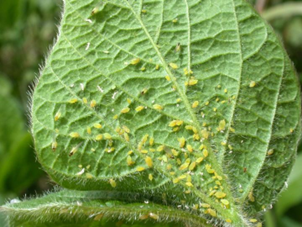
- They suck plant sap, secrete honeydew which causes sooty moulds.
- This affects plant growth, fruit quality and value.
- They also transmit virus diseases during feeding such as the cucumber mosaic virus.
Control
- Natural enemies like ladybirds feed on the Aphis.
- Use yellow sticky traps.
- Use reflective aluminum mulch to deter aphids from landing on plants.
The tomato russet mite (Aculops lycopersici)

- They are yellowish, brown or pink tiny mites.
- They feed on all above-ground parts of the tomato plant, causing spotting, twisting or folding of leaves and fine cracks on the fruits.
- Infested leaves and stems develop a greasy appearance and turn bronze.
- The plants can drop their leaves and expose the fruits to sunburn.
- Damage to the plant typically begins near the ground and spreads upwards.
Control:
- Use of Predatory mites.
- Neem extracts (Neem oil and aqueous neem kernel).
Thrips (Thrips tabaci, Frankliniella occidentalis, F. schultzeii and Ceratothripoides brunneus)
 Source: https://www.greenlife.co.ke/tomato-thrips/
Source: https://www.greenlife.co.ke/tomato-thrips/
- Thrips are very small (about 1 to 2 mm long).
- They usually feed by sucking sap on the lower surface of leaves.
- They also attack and damage flower buds, flowers and fruits leaving a speckling silvery sheen.
- Under heavy infestation attacked buds, and flowers usually fall off and fruits may become deformed.
- They are vectors of viruses such as the Tomato Spotted Wilt Virus.
Control:
- Use Predatory mites (eg. Amblyseius sp.), anthocorid bugs (e.g. Orius spp.), ladybird beetles,
- lacewings, spiders, and the fungus Entomophthora.
- Plough and harrow before transplanting to expose and destroy pupae in the soil.
- Soil solarisation and flooding of previously infested fields prior to planting/transplanting
- Use of bio pesticides like Neem and other plant extracts.
- Spray with PCPB approved chemical insecticides and mix the spray mixture with a sugar solution to attract the thrips out of the flowers.
Major Diseases
Root Knot Nematodes (Meloidogyne spp)

- Severe infestations result in stunted plants.
- Deformed roots results in plant wilting and nutrient deficiencies.
- Swollen damaged roots may become entry point for other disease causing organisms (fungi, bacteria and viruses).
- Control
- Practice Crop rotation, and burn infested plant debris.
- Intercrop with Mexican marigold weeds that repel the nematodes in the soil.
- Use resistant crop varieties.
- Deep plough the field then leave it exposed to the sun for sometime out.
- Use registered nematicide such as Methane Sodium,
- Paecilomyces lilacinus and Azadirachtin among others.
Bacterial Wilt (Pseudomonas solanacearum)
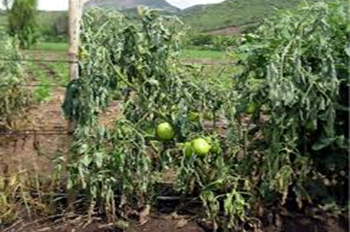
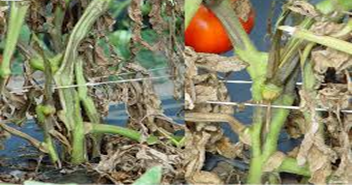
- It is one of the most economic diseases of tomato. This disease causes wilting of tomatoes.
- It is mainly seed borne but pathogens are also found in the soil.
- Symptoms first appear on the youngest leaves and a rapid wilt of the whole plant occurs.
- Testing for this disease can be done by suspending a part of infected stem in water whereby a whitish slimy stream will be observed in the water.
Control
- Practice crop rotation with a non-susceptible crop.
- Raise seedlings in pathogen free soil.
- Remove and burn infected plants.
- Plant resistant tomato varieties.
Late blight (Phytopthora infestans (Mont.) de Bary)

- It’s a very destructive diseases of tomato.
- It attacks all above ground parts of tomato.
- Leaf lesions begin as water soaked spots which rapidly enlarge to brown lesion covering the entire leaf which then dries up.
- Infected leaves shrivel, die and dry up.
- Infected areas on stems appear brown to black.
- Decaying stems produce a rotting smell.
Control
- Maintain the field clean, free from weeds.
- Practice crop rotation.
- Use tomato seedlings from a disease free nursery.
- Apply protective fungicides e.g. Antracol (Propineb), Dithane M-45 (Mancozeb) every 7-10 days and alternte with systemic curative and protective fungicides like Ridomil (Metalaxyl) and Milrax (Propineb+Mancozeb) at 14 day intervals.
Early blight
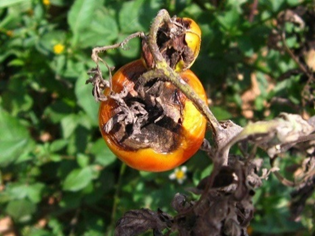

- It is very serious disease on tomatoes during the hot weather.
- It occurs on all above ground parts and is destructive at all stages of crop development.
- It begins as small brownish/black lesions on leaves and later the whole leaf turns yellowish.
- Usually starts on the older leaves and can cause extensive dying and falling of leaves, exposing the fruits to sunburn and lowering of yield.
- On stems, cankers form and occasionally fruits are infected causing premature fruit drop.
- Stem lesions on infected seedlings will continue to enlarge and subsequently girdle the seedlings.
- The most important diagnostic feature of early blight is the formation of dark round rings around the infected spot.
Control
- Deep-plough to bury tomato debris, or remove and destroy infected plants.
- Practice crop rotation.
- Use clean planting seedlings and certified seeds.
- Spray protective fungicides e.g. Antracol (Propineb), Dithane M-45 (Mancozeb) every 7-10 days alternating with systemic curative and protective fungicides like Ridomil (Metalaxyl) and Milrax (Propineb+Mancozeb) at 14 day intervals.
Bacterial canker (Clavibacter michiganensis subsp)

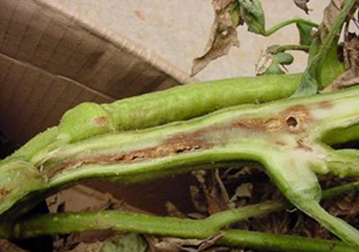

Source:Plantwise.org
- Symptoms do not appear until the disease is well established in the field.
- Symptoms on young seedlings are difficult to see, but often start as dark water soaked areas on leaves and stems.
- Infections result in wilting followed by discoloration of the vascular tissue.
- Stems may split vertically with dark brown necrotic cankers developing under certain conditions.
- Disease development is favored by warm, wet soil conditions.
- The disease can reduce yields by as much as 90%.
- Lower leaves wilt and turn downwards.
- The whole leaf then starts to dry, curls upwards turns brown and withers, but still remain attached to the stems.
- When Stems are split open the middle part of is often found to be discolored.
- Fruit symptoms are patches with raised brown centers surrounded with an opaque halo.
- The most diagnostic feature of bacterial canker is the formation of fruit spots that are bordered by a distinct white halo.
Control
- Use of certified seeds and transplanting into disease-free soil.
- Remove and burn infected plant material.
- Practice crop rotation.
- When pruning, disinfect the pruning knife after every 2 plants using Jik or Dettol.
- Plant Resistant/tolerant varieties.
- Apply copper-containing fungicides to suppress the bacteria.
Fungal Diseases
Fusarium Wilt (Fusarium oxysporum f. sp. lycopersici.)

- Fusarium is common where continuous growing of tomato is practiced and can remain in the soil indefinitely
- Fusarium can come from seed and soil and also hides in weeds
- Thrives well at warm temperatures of 25 – 32 0C and acidic (pH 5.0-5.6) soils
- Infected plants get stunted because the vascular system is affected
- The leaves turn yellow on one side while the other side remain healthy and green
- It causes discoloration of the inner part of the stem and the plants eventually succumbs to the disease and decays.
Control
- Apply lime to increase the pH of the soil (pH 7.0).
- Use nitrate nitrogen rather than ammonium nitrogen.
- Practice crop rotation but avoid crops like peppers, eggplant, potatoes, sunflower, alfalfa, sweet clover.
- Remove and destroy debris and crop leftovers after harvest.
- Avoid flood irrigation.
- Use resistant varieties or graft tomatoes onto resistant rootstocks.
Verticillium Wilt

- Verticillium wilt on tomato. Photo by Lindsey du Toit. Source:Plantwise.org
- This disease is common in cool temperatures (21-25 ºC) and occurs in all tomato-growing regions.
- Symptoms are can sometimes be confused with Fusarium wilt but
- the difference is that plants show wilt symptoms during the warmest period of the day.
- Lower leaves turn yellow (interveinal chlorosis) and falls off the plant.
- These symptoms are easily seen during periods of drought or when the plant is heavy with fruit.
- There is a brown colouration if the stem is cut lengthwise.
Control
- Practice a 3 to 4-year crop rotation but avoid rotating with peppers, eggplant, potatoes, sunflower, alfalfa, sweet clover.
- Remove all debris and crop remains after harvest and control weeds.
- Use clean seeds/seedlings and resistant varieties.
Powdery Mildew-Leveillula taurica

Source: https://www.greenlife.co.ke/powdery-mildew/
- The disease is seen as white powder on the leaves.
- Older plants are more affected.
- Infection occurs when temperatures and humidity are high.
- Disease starts on the upper side and spreads to lower leaf surface.
- Damaged Leaf surface develops yellow patches which later die.
- Reduced leaves results in fruit sunburn and weak plants.
Control
- Remove and destroy crop debris after harvest.
- Keep the field free of weeds and practice crop rotation.
- Use registered chemical products such Azoxystrobin, Myclobutanil, Thiophanate, Tebuconazole,Kresoxim-methyl and Sulfur based fungicides among.
Anthracnose (Colletotrichum spp)

Source:Infornet biovision.org
- This disease is mainly a pathogen of the tomato fruit.
- As the fruit are ripening some small, circular and sunken areas are seen, which later turn dark.
- The infected spots continue to grow larger as the infection spreads deeper into the fruit.
Control
- Ensure crop rotation for 3 about years.
- Remove weeds that can act as hosts.
- Use disease-free or treated seed.
- Use recommended Fungicides (like chlorothalonil) to help reduce the disease.
Viral diseases
Tomato Common Mosaic Virus (TCMV)

Source:Infornet biovision.org
- The disease is seed borne.
- It can be mechanically transmitted through transplanting seedlings and pruning.
- Damage Affected plants show dark and light green mottling effect and some distortion of young leaves, as well as disturbed or
- elongated leaves with a fern leaf characteristic.
- Under high temperatures and high light intensity, mottling is severe while under low temperatures stunting and leaf distortion is severe.
- Fruits are discoloured as well as show brown streaks inside.
Control
- Use resistant varieties and certified disease free seeds.
- Remove crop debris and roots from the field Avoid smoking while in the farm as it is believed the virus is transmitted from tobacco.
- Field hygiene should be well practiced.
- Chemical Control -no chemicals to manage the disease.
Tomato spotted wilt virus (TSWV)

Source:Infornet-biovision.org
- Commonly known as ‘Kijeshi’,
- Important symptoms are seed as rings on the mature fruits which become red and white or yellow and red hence the name Kijeshi (like the army color).
- Other symptoms can be seen as Necrotic spots, streaking, ring spots, stunting and wilting.
- Maily spread by Thrips (Frankinella occidentalis).
Control
- Manage thrips in the field to avoid transmission of the virus.
- Remove (sanitation) and destroy all infected (symptomatic) plants and destroy all weeds. break the disease cycle by avoiding continuous cropping.
Tomato Yellow Leaf Curl Virus (TYLCV)

Source:Infornet-biovision.org
- This disease is mainly transmitted by whiteflies and causes severe loss in yield.
- Whiteflies transmit the disease into the field from infected weeds such as nightshade, Datura stramonium and jimsonweed.
- The leaves curl, turn yellow along the leaf margins (chlorotic), and become smaller than normal.
- Plants have very few flowers hence few fruits or no fruits at all.
Control
- Remove plants with initial symptoms to slow the spread of the disease.
- Practice intercrop with other plants like onions, chives and garlic that trap or repel whiteflies.
- Maize crop can also be planted as border crop to reduce the movement of whiteflies towards the crop.
- Use sticky traps to control the
- vectors population.
- Control weeds that act as alternate hosts for the whiteflies.
- White flies should be controlled to discourage spread of the virus; for instance, by use of oil sprays.
Nutritional disorders
|
|
|
|
|
|
- Common in soils that are poor in organic matter.
- They are observed as patterns of leaf discoloration or fruit abnormality.
- The common nutritional disorders in tomato are;
- Blossom end rot caused by calcium deficiency.
- Chlorosis of older leaves due to nitrogen deficiency.
- Stunted growth, purpling of leaves and late fruit maturation due to phosphorus deficiency.
- Drying of leaf margins coupled with hollow fruit due to potassium deficiency.
They can be corrected by application of foliar fertilizers (foliar feeds).
- This is a technique in which a plant with proven resistance to soilborne pathogens is used to enable the production of a high yielding variety that has high market demand but highly susceptible to the soil borne pathogen.
- The preferred variety is used as the source of scion and joined to the resistant variety which serves as a rootstock.
- Susceptible tomato varieties with high market demand can be grafted onto wilt resistant germplasm of Solanum incanum, Eggplant or MT56.
This could enable their production even in soil with bacterial wilt disease.
Resistant varieties
- Resistant varieties have inherent genetic capacity to tolerate and/or resist important pests and diseases.
- When purchasing seed, farmers should ask for varieties that are tolerant to the main pests and diseases common in their regions.
- Read the different codes on the label to identify tolerance of different varieties.
- For example; VFN indicate tolerance to Verticilium wilt (V), Fusarium wilt (F) and Nematodes (N). A is for Alternaria leaf spot; TSWV for Tomato Spotted wilt virus.
- Fortune Maker, Kentom, Taiwan F1, and Zara F1 among others have tolerance to bacterial wilt.
- Roma VNF, Shengena, Tengeru-97, Kentom and Shanty F1 among others are tolerant to root knot nematodes.
Seed dressing
- Helps prevent early pest and disease infestation.
- Treat Seeds with chemical pesticides such as Thiram, Apron Star, Celest®Top, Cruiser® 350FS, Dividend® 030fs, Maxim Xl® 035FS, Seed Plus 30WS, Mancolax 72% WP, Marshal 350 ST, Protreat 350fs.
- Place the seeds in a container and mix with the chemical according to the instructions on the label.
Maturity
- This is identification of maturity indices used to determine the appropriate stage to harvest tomato fruit.
- The parameters used are physical (colour, size, texture) and chemical (brix)
- Tomatoes destined for various markets and end use should be harvested at the appropriate time
- This ensures good quality of produce with long shelf-life.
 Tomato ripening stages
Tomato ripening stages -
Harvest index
Characteristics
Use
Breaker
10% of the fruits break colour from green to pink or red
Fruits are harvested to send to distant markets
Light red
60-90% of pink or red colour
Fruits are picked for the local market
Turning
10-30% of pink or red colour
Fruits are consumed or used for canning and processing
Pink
30-60% of pink or red colour
Frits are consumed or used for canning and processing
- Harvesting done at different stages depending on the market requirement and distance to the market
- Harvesting is done by hand by twisting and turning until the fruits snap off the vine.
- Harvesting should preferably done early in the morning when temperatures are cool.
- Hold in non-collapsible containers made of wood, plastic or polysterene.
- The containers should be open on the side to encourage heat loss.
- Transportation from farm to the market should be done early in the morning when temperatures are cool and care should be taken to avoid damaging the tomatoes.
- Sorting is done to remove rotten, damaged, cracked and diseased fruits, and debris. Sorting limits spread of infection to healthy fruits during post-harvest handling.
- Grading is categorization of fruits on the basis of color, size and stage of maturity / degree of ripening.
- Tomatoes are highly perishable therefore should be stored at low temperature and high relative humidity to enhance their shelf life.
- The fruits are delicate thus require careful handling from harvesting up to market to ensure maintenance of good quality and reduce postharvest losses.
- Use barrier packaging material such as polybags (Modified atmospheric Packaging -MAP) that controls exchange of gas in and out of packaging containers.
- Zero Energy cooling Unit like the charcoal cooler also offers short time storage for fresh produce.
- It reduces the temperature and increases relative humidity during storage thus maintaining the freshness of the tomato.
- They can also be Solar dried thus enhances shelf life and ensuring availability during off season.

- Fresh tomato can be value added by processing into pulp and make products such as sauce, paste and ketchup.



- Low powered, two-wheeled, 8-16hp agricultural implement (a walking tractor)
- Can be attached to a rotary tiller, disk harrow, mouldboard plough, trailer, water pump or chisel plough at alternate times for easing farm operations.
- Can plough one hectare 2 hours.
- Fuel consumption is about 15 litres per ha.

Power tiller

Wheeled tractor
- Small sized, 4 wheeled, 30-55hp tractor
- Can be attached to a rotary tiller, disk harrow, mouldboard plough, trailer, water pump or chisel at alternate times for easing farm operations.
- Can complete 4 hectares in 8 hours and double that figure when two operators are used.
- Fuel consumption is about 15 litres per ha.

Motorized Sprayer
- Used in spraying insecticides, herbicides, fertilizers, water on agricultural crops on the farm.
- Uses gasoline mixed with engine oil to function.
Basic cost/estimated returns
- Basic cost will depend on the acreage cultivate and the management practices applied.
- Estimated returns depend on the management practices.
Internet, online and mobile marketing
- Internet marketing reduces costs. Examples of internet markets are:
- National Farmers Information Service(NAFIS) can be found using phone by typing http://www.nafis.go.ke on google.
- Kenya Market Information System(KAMIS)can be found using the phone by typing http://www.amis.co.ke .
Further reading
 1
1 3
3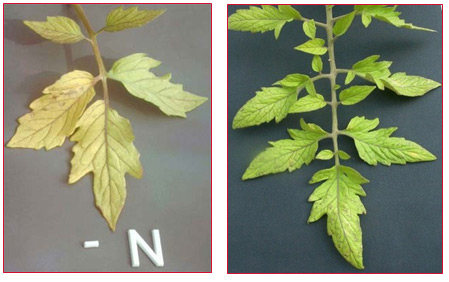 2
2 4
4